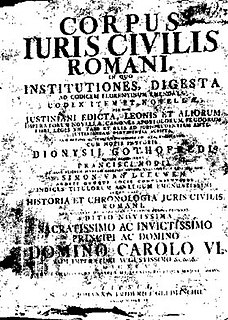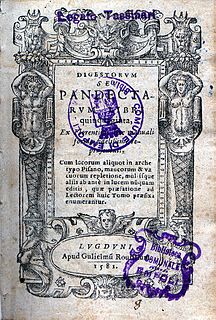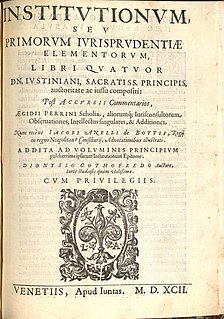
Roman law is the legal system of ancient Rome, including the legal developments spanning over a thousand years of jurisprudence, from the Twelve Tables, to the Corpus Juris Civilis ordered by Eastern Roman Emperor Justinian I. Roman law forms the basic framework for civil law, the most widely used legal system today, and the terms are sometimes used synonymously. The historical importance of Roman law is reflected by the continued use of Latin legal terminology in many legal systems influenced by it, including common law.

The Corpus JurisCivilis is the modern name for a collection of fundamental works in jurisprudence, issued from 529 to 534 by order of Justinian I, Byzantine Emperor. It is also sometimes referred to metonymically after one of its parts, the Code of Justinian.

Tribonian was a notable Byzantine jurist and advisor, who during the reign of the Emperor Justinian I, supervised the revision of the legal code of the Byzantine Empire.

The Digest, also known as the Pandects, is a name given to a compendium or digest of juristic writings on Roman law compiled by order of the Byzantine emperor Justinian I in the 6th century CE (530–533). It is divided into 50 books.

Gaius was a celebrated Roman jurist. Scholars know very little of his personal life. It is impossible to discover even his full name, Gaius or Caius being merely his personal name (praenomen). As with his name it is difficult to ascertain the span of his life, but it is safe to assume he lived from AD 110 to at least AD 179, since he wrote on legislation passed within that time.

The Codex Theodosianus was a compilation of the laws of the Roman Empire under the Christian emperors since 312. A commission was established by Emperor Theodosius II and his co-emperor Valentinian III on 26 March 429 and the compilation was published by a constitution of 15 February 438. It went into force in the eastern and western parts of the empire on 1 January 439. The original text of the codex is also found in the Breviary of Alaric, promulgated on 2 February 506.

Accursius was a Roman jurist. He is notable for his organization of the glosses, the medieval comments on Justinian's codification of Roman law, the Corpus Juris Civilis. He was not proficient in the classics, but he was called "the Idol of the Jurisconsults".

Irnerius, sometimes referred to as lucerna juris, was an Italian jurist, and founder of the School of Glossators and thus of the tradition of Medieval Roman Law.

Byzantine law was essentially a continuation of Roman law with increased Christian influence. Most sources define Byzantine law as the Roman legal traditions starting after the reign of Justinian I in the 6th century and ending with the Fall of Constantinople in the 15th century.

A nomocanon is a collection of ecclesiastical law, consisting of the elements from both the Civil law and the Canon law. Nomocanons form part of the canon law of the Eastern Catholic Churches and of the Eastern Orthodox Churches.
The Corpus Juris Canonici is a collection of significant sources of the canon law of the Catholic Church that was applicable to the Latin Church. It was replaced by the 1917 Code of Canon Law which went into effect in 1918. The 1917 Code was later replaced by the 1983 Code of Canon Law, the codification of canon law currently in effect for the Latin Church. In 1990, Oriental canon law was codified in the Code of Canons of the Eastern Churches, which is currently in effect for the Eastern Catholic Churches.
The Codex Hermogenianus is the title of a collection of constitutions of the Roman emperors of the first tetrarchy, mostly from the years 293–94. Most of the work is now lost. The work became a standard reference in late antiquity, until it was superseded by the Breviary of Alaric and the Codex Justinianeus.

The Basilika was a collection of laws completed c. 892 AD in Constantinople by order of the Byzantine Emperor Leo VI the Wise during the Macedonian dynasty. This was a continuation of the efforts of his father, Basil I, to simplify and adapt the Emperor Justinian I's Corpus Juris Civilis code of law issued between 529 and 534 which had become outdated. The term "Basilika" comes not from the Emperor Basil's name, but rather from Greek: Τὰ Βασιλικά meaning "Royal Laws".
Fred Heinrich Blume, or Fred H. Blume, as he referred to himself, was a German-born American attorney and judge. He served as a Justice of the Wyoming Supreme Court for 42 years, from 1922 to 1963, and by himself translated from Latin into English the Codex Justinianus and the Novels, two parts of the Corpus Juris Civilis.
The Novellae Constitutiones, or Justinian's Novels, are now considered one of the four major units of Roman law initiated by Roman Emperor Justinian I in the course of his long reign. The other three pieces are: the Codex Justinianus, the Digest, and the Institutes. Justinian's quaestor Tribonian was primarily responsible for compiling these last three. Together, the four parts are known as the Corpus Juris Civilis. Whereas the Code, Digest, and Institutes were designed by Justinian as coherent works, the Novels are diverse laws enacted after 534 that never were officially compiled during his reign.

The law school of Berytus was a center for the study of Roman law in classical antiquity located in Berytus. It flourished under the patronage of the Roman emperors and functioned as the Roman Empire's preeminent center of jurisprudence until its destruction in AD 551.

The Institutes of Justinian is a unit of the Corpus Juris Civilis, the sixth-century codification of Roman law ordered by the Byzantine emperor Justinian I. It is largely based upon the Institutes of Gaius, a Roman jurist of the second century A.D. The other units in the Corpus Juris Civilis are the Digest, the Codex Justinianus, and the Novellae Constitutiones.

The Code of Justinian is one part of the Corpus Juris Civilis, the codification of Roman law ordered early in the 6th century AD by Justinian I, who was an Eastern Roman (Byzantine) emperor in Constantinople. Two other units, the Digest and the Institutes, were created during his reign. The fourth part, the Novellae Constitutiones, was compiled unofficially after his death but is now also thought of as part of the Corpus Juris Civilis.












